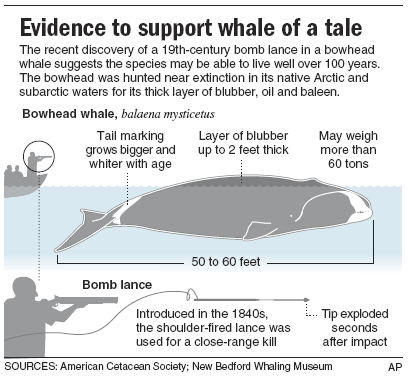tags: bowhead whale, whaling, aging whales
This bomb lance fragment, patented in 1879, was removed from the neck of a male bowhead whale, Balaena mysticetus, killed near Barrow, Alaska, in May 2007. The shiny scars are the result of a chain saw cut.
Image: AP.
Here's an interesting twist to a sad story: In May of this year, eskimos killed a 49-foot male bowhead whale, Balaena mysticetus, off the coast of Alaska and unexpectedly discovered that he had survived a similar hunt more than a century ago. While butchering the whale's body with a chainsaw, they found that he was carrying a 3 1/2-inch arrow-shaped bomb lance fragment (top) that was embedded 13 centimenters under the blubber in his neck, providing researchers with rare insight into this individual's age, which was estimated to be between 115 and 130 years old.
"No other finding has been this precise," said John Bockstoce, an adjunct curator of the New Bedford Whaling Museum.
Scientists calculate a whale's age by chemically analyzing the amino acids in the animal's eye lenses. Individual amino acids accumulate structural changes in whales' eye lenses making them cloudier as they age. Experts mentioned that even though it's unusual to find a whale that is more than a century old, several bowheads have been found that were close to 200 years old. Based on what is known about the bomb lance fragment, this individual was estimated to be roughly 130 years old, so it would have been born in 1877.
The bomb lance fragment was lodged between bones in the whale's neck and shoulder blade. The fragment is comprised of a small metal cylinder filled with explosives and fitted with a time-delay fuse so it would explode several seconds after penetrating the whale. This exploding feature was meant to kill a whale and thereby prevent it from escaping. Instead, the device exploded and only injured the whale.
"It probably hurt the whale, or annoyed him, but it hit him in a non-lethal place," Bockstoce observed. "He couldn't have been that bothered if he lived for another 100 years."
The bomb lance fragment was shot into the whale from a heavy shoulder gun around 1890 and was probably manufactured in New Bedford, on the southeast coast of Massachusetts, which was a major whaling center at that time.
The last time this particular whale was struck with a pointy explosive object, Rutherford B. Hayes was president, federal Reconstruction troops had withdrawn from the South and Thomas Edison had unveiled his newest invention, the phonograph.
"It's unusual to find old things like that in whales, and I knew immediately that it was quite old by its shape," said Craig George, a wildlife biologist for the North Slope Borough Department of Wildlife Management, who was called to the site soon after the lance was found. He noted that a similar object had been found in a whale killed near St. Lawrence Island in 1980.
"We didn't make anything of it at the time, and no one had any idea about their lifespan, or speculated that a bowhead could be that old," George said.
The fragment will be displayed at the Inupiat Heritage Center in Barrow, Alaska.
Recently, the International Whaling Commission renewed a hunting quota for the Alaska Eskimo Whaling Commission, allowing 255 whales to be killed by 10 Alaskan villages during a five year period. Whale meat has always been a prominent source of food for native eskimos.
The recent discovery of a 19th-century bomb lance in a bowhead whale suggests that this species can live well over 100 years. The bowhead whale was hunted to near extinction in its native Arctic and subarctyic waters for its thick layer of blubber, oil and baleen.
Image: AP (American Cetacean Society and New Bedford Whaling Museum)
Sources
The Times (quotes)
AP (quotes, images)



I wrote a feature piece on this subject for a couple of magazines (New Scientist and Equinox)seven years ago. It's at
http://cyamid.net/science/immortals.html
wow, thanks for the link. it's very informative. i also will admit to feeling a little jealousy knowing that you wrote for New Scientist -- i adore that magazine!
The New Scientist version is a bit shorter and includes some comparison ecology:
http://cyamid.net/science/oldman.html
This is a very sad saga. For this highly intelligient creature to have been assaulted twice and killed after nearly having his species nearly erradicated is unconscionable. On occasions like this I am ashamed to be a human. Barbaric.
In the case of the Inuit, the hunting should be akin to sustainable predation. Massively unfortunate for the whale concerned, and it does make one feel sad, but otherwise is not a big deal.
But in the case of the earlier hunters, or the so-called "scientific hunting" done now by Japan and a few other countries, it isn't predation. Or sustainable. And there is very very little science or data that results (I'm tempted to say we've learned more from this one incident than we have from the whales killed by Japan since the start of the IWC "ban"). It is this pointless industrial-scale killing that is the big deal.